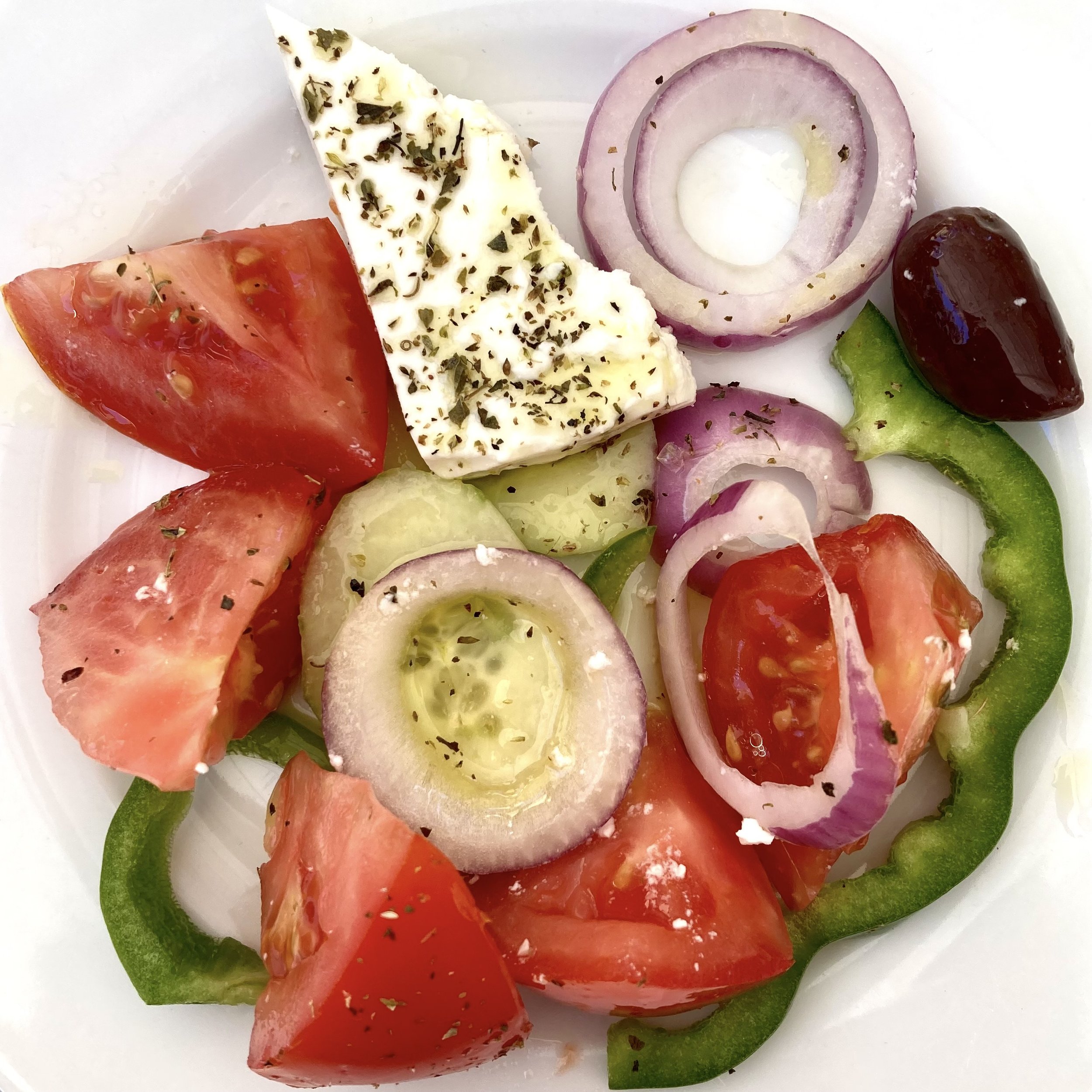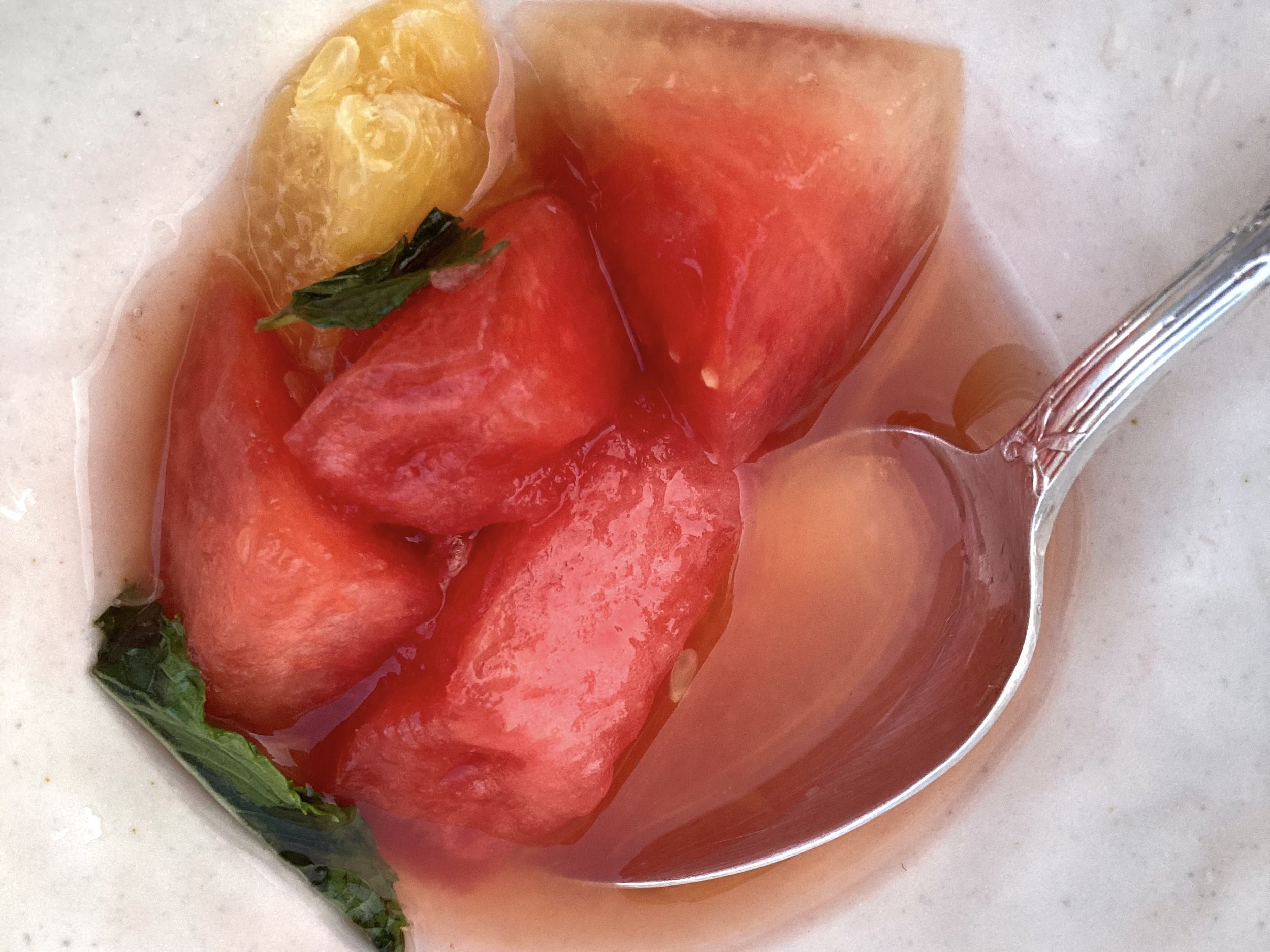The Mediterranean diet and its cousin, the Atlantic diet: introduction and variations.
updated: 27.3.2025
The Mediterranean and Atlantic traditional diets focus on natural whole foods and meaningful social connections.
The Mediterranean and Atlantic diets:
Emphasise fresh, natural, seasonal ingredients, and minimally processed foods.
Incorporate a variety of vegetables, legumes, and whole grains. Seafood is a primary protein source.
Return to a simpler, healthier way of eating and living.
Greek salad, with tomatoes, cucumbers, peppers, olives, feta, oregano, and olive oil. Its a perfect summer dish, often served alone as a light meal, or alongside grilled seafood or meats. It has no lettuce.
Grilled fish (sardines). Sardines are rich in omega-3 fatty acids (particularly EPA and DHA), in protein, vitamins (B12, D), and minerals (calcium, selenium). Importantly, they are low in mercury compared to other fish, and are a more sustainable seafood choice. These were later garnished with parsley, olive oli, and lemon juice.
A simple desert: fresh fruit (watermelon and orange) with honey and mint leaves. Almonds can be added for enhanced flavour and texture.
The Mediterranean diet.
The Mediterranean diet, common in southern Europe - including Spain, Italy, Greece, and parts of France - emphasizes olive oil, fresh vegetables, fruits, legumes, nuts, whole grains, fish, and moderate wine consumption. Protein sources come primarily from fish and seafood, with moderate amounts of poultry and dairy, while red meat is consumed sparingly. The diet is rich in healthy monounsaturated fats from olive oil, nuts, and seeds. Cooking methods include grilling, roasting, and sautéing with olive oil.
The Mediterranean diet has been extensively studied and reviewed. It is widely recognized for its health benefits, including improved cardiovascular health, longevity, reduced inflammation, and lower rates of obesity and neurodegenerative diseases.
Mediterranean fusion diets.
Mediterranean fusion diets incorporate spices, techniques, and ingredients from various cultures - while maintaining the core Mediterranean emphasis on plant-based nutrition and healthy fats. It combines Mediterranean staples with modern superfoods and international flavors.
Some examples are miso-infused hummus (Japanese-Mediterranean blend), tacos with grilled halloumi and tzatziki (Greek-Mexican fusion), quinoa tabbouleh with avocado (modern take on Levantine cuisine).
The Atlantic diet (“Atlantic diet pattern”).
The Atlantic diet pattern is closely related to the Mediterranean diet. The diet is adapted to the Atlantic climate and local products of northwestern Spain, Portugal, parts of France, and Ireland. It incorporates fresh seafood, dairy products, whole grains, potatoes, beans, and leafy greens. It places greater emphasis on protein intake. It includes more shellfish and fish (cod, sardines, and hake), dairy, and red meat, especially beef and pork. Monounsaturated fats from olive oil are balanced with saturated fats from dairy and pork fat.
Cooking methods favor stewing, boiling, baking, and slow-cooking over grilling.
The Atlantic diet is increasingly studied for its health benefits. It contributes to cardiovascular health, has anti-inflammatory effects, and helps with weight management and metabolic health. It may also offer protection against cognitive decline.
Cazuela de marisco y pulpo seafood stew (Galicia, Spain). The stew combines octopus and shellfish in a white wine, paprika, and saffron broth.
A Mediterranean-Atlantic fusion diet and lifestyle blends both traditions.
A blend of the Mediterranean, and Atlantic eating habits balances nutrition and socialization, with a joyful, active lifestyle and a sustainable way of living. It prioritizes balance, quality ingredients, and a connection to food, culture, and community.
It is plant-based, promoting fresh, seasonal, and nutrient-dense ingredients.
It embraces balance and moderation, rather than on resticting food groups.
It’s about balance, joy, and mindful eating, and reinforces the importance of social connections. Taking time to enjoy food, savor flavors, and engage in conversation enhances both physical and mental well-being.
Cooking together is much more than just about preparing food. It provides significant mental and social health benefits.
It strengthens social bonds encouraging communication, teamwork, and sharing of experiences, and reduces feelings of loneliness.
Cooking with others can relieve stress, engaging the senses in a mindful, creative process. It helps children develop lifelong cooking skills and a better relationship with food.
Food is shared, often as part of intergenerational gatherings, and meals are rarely eaten alone or in haste. This reinforces the importance of connection, conversation, and slowing down to appreciate each bite.
Mediterranean and Atlantic diets.
Caldo de chourizo con patatas y zanahorias (Galicia, Spain) is a rustic stew of chorizo, potatoes, carrots, onions and tomatoes in a paprika and garlic broth.
Core principles of a Mediterranean-Atlantic fusion diet and lifestyle.
Ingredients are simple, whole, prepared with care, and shared with others.
Olive oil is the primary fat, with some butter and dairy fats.
Vegetables are center stage, with proteins such as fish, poultry, dairy and meats playing a supporting role. Mediterranean and Atlantic fruits and vegetables (Mediterranean tomatoes, eggplant, peppers, chickpeas, lentils, together with Atlantic kale, cabbage, turnip greens, rye, barley, potatoes) are combined.
Carbohydrates in the Mediterranean diet are mostly complex, fiber-rich carbohydrates from whole grains, legumes, vegetables, and fruits. The Atlantic diet incorporates starchier and heartier carbohydrate sources, reflecting the colder climate and traditional farming practices.
The main Mediterranean diet carbohydrate sources are whole grains (farro, bulgur, barley, whole-wheat bread, and brown rice are staples, often eaten in small portions alongside vegetables and proteins), legumes (lentils, chickpeas, and beans), vegetables (zucchini, eggplant, peppers, and leafy greens), and fruits (tomatoes, figs, grapes, citrus, and pomegranates). Traditional Mediterranean diets limit white bread and pasta, favoring whole-grain alternatives and moderate portion sizes.
The Atlantic diet’s key carbohydrate sources are potatoes, whole grains (rye, barley, brown rice, and whole-wheat bread), legumes (beans, chickpeas, and lentils), root vegetables (turnips, carrots, and onions), bread and pasta. Refined grains are more common than in the Mediterranean diet.
Seafood (fish and crustaceans) are prioritised over moderate meat consumption. Dairy is used in moderation, and includes fermented dairy (yogurt, cheese).
Seasonal and local food (fresh, regional) are prioritised. This ensures fresher, more flavorful ingredients while supporting sustainability.
Diverse cooking methods are used: Mediterranean grilling and roasting and Atlantic stewing and slow-cooking.
Wine (typically red) is consumed in moderation, with meals and in social settings.
Meals are typically eaten slowly together with friends, family or acquaintances, and less frequently alone or in haste. Many meals are accompanied by lively discussions, laughter, and often extend well beyond the food itself. This promotes mental and emotional well-being as much as physical health.
Natural movement occurs as a part of daily life in the Mediterranean and Atlantic regions. Activities such as walking, gardening, and cycling complement their way of eating.
Adaptations to the Mediterranean-Atlantic fusion diet .
Plant-based.
Emphasises legumes, nuts, and plant proteins instead of fish and poultry. Uses tofu, tempeh, or lentils in traditional Mediterranean and Atlantic dishes and cashew-based tzatziki or almond-based feta as dairy alternatives.
Low-carbohydrate.
Uses zucchini noodles, cauliflower rice, and legume-based pasta, and less bread, and pasta. Focuses on healthy fats from avocado, nuts, and olive oil. Prioritizes lean proteins like fish, chicken, and eggs.
Functional and gut-health diet.
Focus on fermented foods (kimchi, kefir, and probiotic-rich yogurt), “gut-friendly” fibers (flaxseeds, psyllium husk). Enhances anti-inflammatory spices (turmeric and ginger).
High-protein diet for athletes.
Increases lean proteins (wild fish, pasture-raised eggs, and Greek yogurt), superfoods (spirulina, hemp seeds, and bone broth), and energy snacks (almond-stuffed dates, chickpea protein bars).
The planetary diet, a similar, but more sustainable diet.
The planetary health diet (PHD) is associated with healthy aging. It integrates sustainability by promoting plant-based protein sources. More climate-friendly food choices including oats, nuts, seeds, legumes, and plant-based dairy alternatives, are preferred over dairy and animal products. (Figure adapted from: Willett, Walter et al. Food in the Anthropocene: the EAT-Lancet Commission on healthy diets from sustainable food systems. Lancet, 2019;393:447- 492.)
In a recent report (Optimal dietary patterns for healthy aging. Nat Med, 2025. https://doi.org/10.1038/s41591-025-03570-5), the Planetary Health Diet, designed as a sustainable dietary model, appeared to confer the greatest health benefits when compared to other diets rich in plant-based foods and moderate amounts of animal-based foods. Although the differences among dietary patterns were relatively modest, all diets studied were associated with healthy aging.







